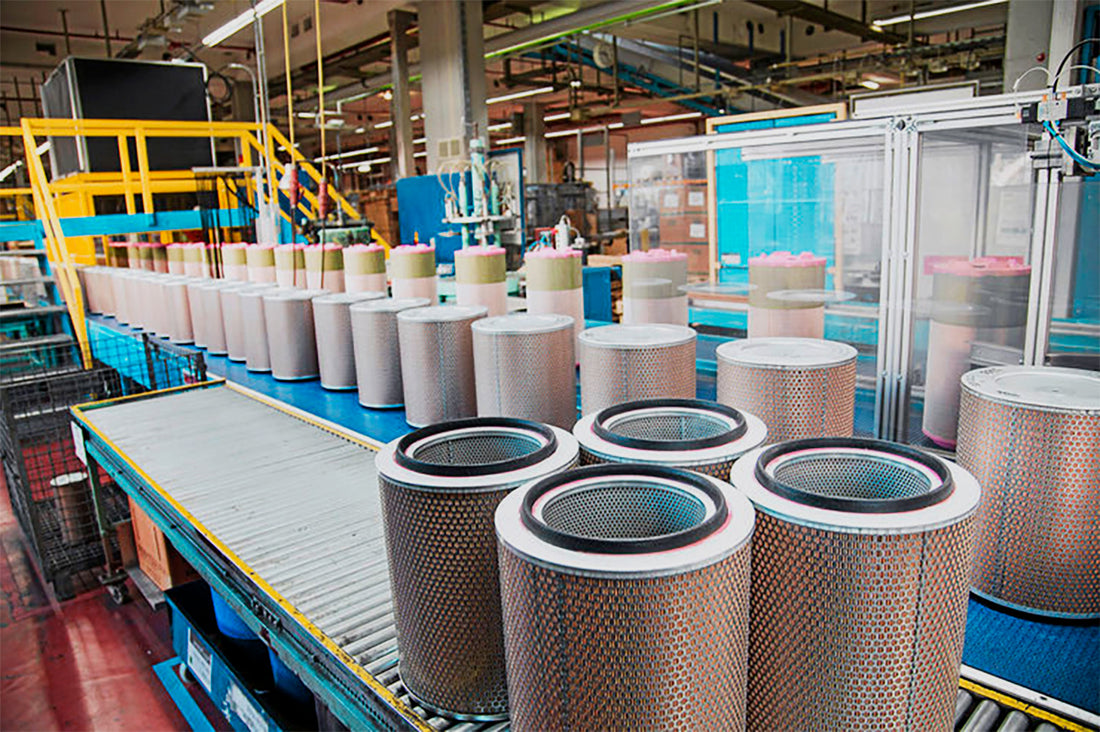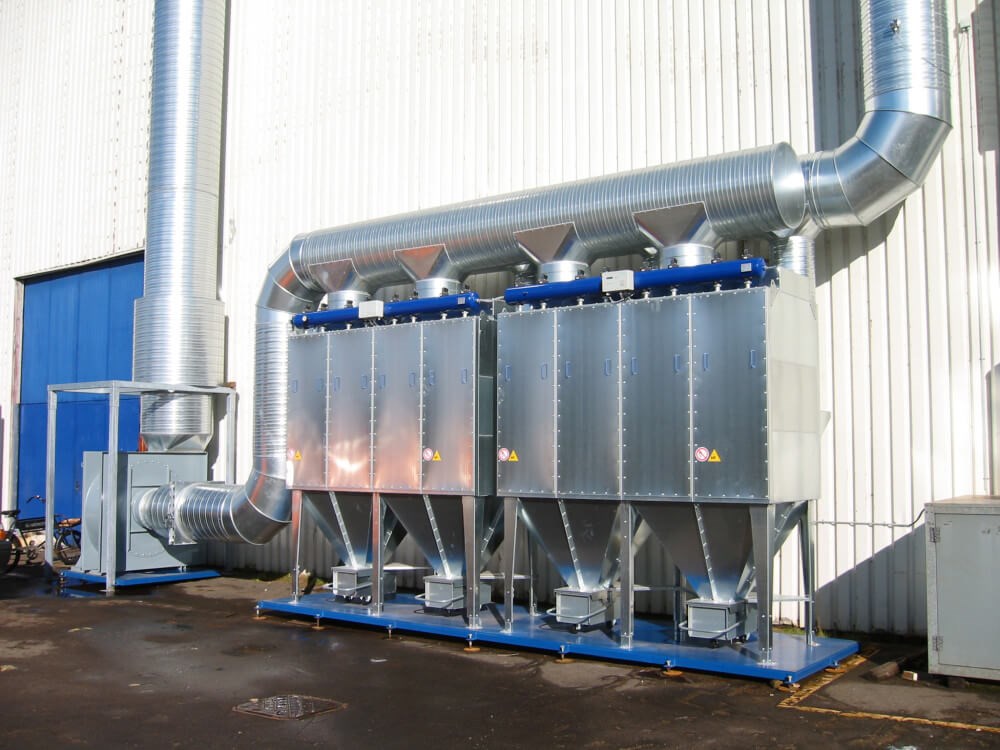As industrial activities intensify, maintaining air quality in factories has become critical for worker safety, equipment longevity, and regulatory compliance. In 2025, air filtration technologies like High-Efficiency Particulate Air (HEPA) filters, baghouse systems, cartridge collectors, and dust collectors are at the forefront of addressing these needs. Innovations such as nanofiber filters are further enhancing efficiency and sustainability, helping industries like cement, automotive, and manufacturing meet stringent environmental regulations. This article explores these technologies, their applications, efficiencies, and the role of cutting-edge advancements in shaping the future of industrial air filtration.
The Importance of Air Filtration in Factories
Factories, particularly in industries like cement, automotive, and manufacturing, generate significant amounts of dust, fumes, and particulate matter. These pollutants pose health risks to workers, damage machinery, and contribute to environmental degradation. According to the World Health Organization, air pollution causes approximately 7 million premature deaths annually, with industrial emissions being a significant contributor. Stringent regulations, such as those enforced by the U.S. Environmental Protection Agency (EPA) and the European Union’s Industrial Emissions Directive, mandate factories to control emissions effectively.

Air filtration systems are essential for capturing harmful particles, ensuring compliance, and maintaining clean production environments. The global industrial air filtration market, valued at $17.5 billion in 2024, is projected to reach $30 billion by 2032, driven by rising industrialization and regulatory pressures. Technologies like HEPA, baghouse, cartridge, and dust collectors, alongside innovations like nanofiber filters, are pivotal in this growth.
Read more: DIY Vs. Professional Installation: Setting Up Your Pool Filtration System
Key Air Filter Technologies for Factories
HEPA Filters
HEPA filters are renowned for their ability to capture 99.97% of particles as small as 0.3 microns, making them ideal for environments requiring high air purity. In factories, HEPA filters are used in cleanrooms (e.g., pharmaceuticals, semiconductors) and automotive manufacturing, where they prevent microscopic contaminants from affecting sensitive processes. For instance, HEPA filters in automotive plants ensure clean air for precision tasks like painting and assembly, reducing defects.
Efficiency and Applications: HEPA filters excel in capturing fine dust, bacteria, and spores, making them indispensable in industries with strict hygiene standards. In cement factories, HEPA filters complement other systems by capturing ultra-fine particles that escape primary filtration. Their high efficiency comes at the cost of higher pressure drops, which can increase energy consumption, but advancements like low-delta-pressure designs (e.g., Hollingsworth & Vose’s NANOWEB) mitigate this issue.
Innovations: In 2025, HEPA filters are seeing advancements in filter media, such as synthetic NANOWEB, which extends service intervals and reduces energy costs. These filters are also being integrated into portable air purifiers for targeted applications in manufacturing facilities.
Baghouse Filters
Baghouse filters, also known as fabric filters, use woven or felted fabric bags to capture dust from industrial gas streams. They are widely used in high-dust-load industries like cement, metals, and power generation due to their 99%+ particulate collection efficiency, even for very small particles. Baghouses became prominent in the late 1970s with the development of high-temperature fabrics capable of withstanding over 350°F, making them suitable for harsh environments.
Efficiency and Applications: Baghouse systems, such as pulse-jet, reverse-air, and shaker types, are highly effective in cement plants, where they capture limestone, clinker dust, and silica during crushing and grinding processes. In automotive manufacturing, baghouses manage welding fumes and metal dust, ensuring worker safety and regulatory compliance. Pulse-jet baghouses, which use compressed air for cleaning, dominate due to their continuous operation and low maintenance.
Innovations: The adoption of nanofiber membranes and expanded polytetrafluoroethylene (ePTFE) coatings enhances baghouse performance by improving surface loading and dust release, reducing cleaning frequency and energy use. For example, Donaldson’s Synteq XP filter media reduces energy consumption by up to 40% due to lower pressure drops.
Read more: Reducing Your Carbon Footprint With Smart Home Tech And Energy Efficient Windows
Cartridge Collectors
Cartridge collectors use pleated, nonwoven filter media in cylindrical cartridges, offering a compact alternative to baghouses for lower dust loads and temperatures below 250°F. They are popular in automotive and manufacturing industries for their ease of maintenance and high filtration efficiency.
Efficiency and Applications: Cartridge collectors achieve up to 99.9% efficiency in capturing dust particles, making them ideal for automotive plants handling paint booth overspray or metalworking dust. In manufacturing, they are used in woodworking and food processing to manage fine particulates like sawdust or flour. Their compact design allows for smaller system footprints, reducing installation costs.
Innovations: Nanofiber-coated cartridges, such as Nederman’s type 178 media, improve surface loading and dust release, lowering operating costs and enhancing airflow. These advancements allow cartridge collectors to handle finer dust particles and extend filter lifespans, making them cost-effective for factories.
Dust Collectors
Dust collectors are broad systems encompassing baghouses, cartridge collectors, and cyclones, designed to remove particulate matter from industrial air streams. They dominate the market, holding over 28% of revenue share in 2023 due to their versatility across industries.
Efficiency and Applications: Dust collectors are critical in cement production, capturing large volumes of dust during crushing and kiln operations. In automotive manufacturing, they manage welding fumes and grinding dust, while in general manufacturing, they protect equipment from dust buildup. Their efficiency, often exceeding 99.9%, supports compliance with OSHA and EPA standards.
Innovations: Smart dust collectors with sensor-based monitoring and predictive maintenance are gaining traction in 2025. For example, Donaldson’s PowerCore technology offers a 70% smaller footprint and lower energy consumption compared to traditional systems, ideal for space-constrained factories.
Industry-Specific Applications
Cement Industry
Cement production generates significant dust during crushing, grinding, and kiln operations. Baghouse filters and dust collectors are primary solutions, capturing coarse particles, while HEPA filters address fine dust in cleanroom-like environments (e.g., quality control labs). The cement segment held a 27% market share in 2023, driven by global construction growth and environmental regulations. Nanofiber-enhanced baghouses improve filtration efficiency, ensuring compliance with emission standards.
Automotive Industry
Automotive manufacturing relies on HEPA and cartridge collectors for clean air in painting, welding, and assembly processes. HEPA filters, like MANN+HUMMEL’s H13 models, remove fine contaminants, ensuring defect-free finishes. Dust collectors manage welding fumes, protecting workers and equipment. The rise of electric vehicles has increased demand for advanced filtration to maintain air quality in battery production.
General Manufacturing
Manufacturing facilities, including metalworking and woodworking, use a combination of baghouses, cartridge collectors, and dust collectors. These systems address diverse pollutants like metal dust, sawdust, and chemical fumes. Nanofiber filters enhance efficiency, reducing maintenance costs and downtime.
Innovations Driving the Future
Nanofiber Filters
Nanofiber technology, characterized by ultra-thin fibers (1/3000th the thickness of traditional media), revolutionizes air filtration by enabling surface loading rather than depth loading. This improves dust release, reduces pressure drops, and lowers energy consumption. Companies like Nederman and Hollingsworth & Vose are integrating nanofiber media into cartridge and baghouse systems, extending filter lifespans and improving efficiency in cement and automotive applications.

Smart Filtration Systems
Industry 4.0 integration is transforming air filtration with smart dust collectors equipped with sensors for real-time monitoring. These systems optimize cleaning cycles, reduce energy use, and predict maintenance needs, enhancing operational efficiency in manufacturing plants.
Sustainable Solutions
Sustainability is a key driver in 2025, with manufacturers adopting reusable and washable filter media. Biodegradable materials and energy-efficient designs, such as Donaldson’s PowerCore, align with green manufacturing goals, reducing environmental impact.
Regulatory Compliance and Market Growth
Stringent regulations, such as OSHA’s workplace safety standards and the EPA’s emission limits, are pushing factories to adopt advanced filtration systems. The EU’s Industrial Emissions Directive and ASHRAE standards further emphasize high-efficiency filters like HEPA and nanofiber-enhanced baghouses. The industrial air filtration market is expected to grow from $18.63 billion in 2025 to $32.09 billion by 2034, with a CAGR of 6.23%, driven by these regulations and demand from industries like cement and automotive.
Challenges and Considerations
Despite their benefits, air filtration systems face challenges:
-
High Initial Costs: Advanced systems like nanofiber-enhanced baghouses require significant upfront investment.
-
Maintenance Needs: Regular cleaning and filter replacement are essential to maintain efficiency, particularly for HEPA and cartridge systems.
-
Supply Chain Issues: Disruptions in raw material supply can impact filter production, though normalization is expected post-2025.
To address these, factories should invest in training for maintenance staff and partner with reliable suppliers like AirMax Filters or FabCo for customized solutions.
Conclusion
In 2025, HEPA, baghouse, cartridge, and dust collectors remain the backbone of industrial air filtration, with each technology tailored to specific factory needs. Innovations like nanofiber filters and smart systems are enhancing efficiency, reducing costs, and ensuring compliance with stringent regulations. For industries like cement, automotive, and manufacturing, these technologies not only improve air quality but also enhance productivity and sustainability. As the industrial air filtration market continues to grow, adopting these advanced solutions will be critical for factories aiming to thrive in a cleaner, safer, and more regulated future.


.jpg)










